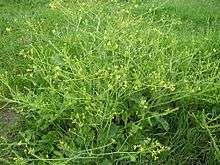Raphanus raphanistrum
| Raphanus raphanistrum | |
|---|---|
 | |
| Scientific classification | |
| Kingdom: | Plantae |
| (unranked): | Angiosperms |
| (unranked): | Eudicots |
| (unranked): | Rosids |
| Order: | Brassicales |
| Family: | Brassicaceae |
| Genus: | Raphanus |
| Species: | R. raphanistrum |
| Binomial name | |
| Raphanus raphanistrum L. | |

Raphanus raphanistrum, the wild radish[1] or jointed charlock, is a flowering plant in the family Brassicaceae. It is sometimes claimed to be the ancestor of the edible radish, Raphanus sativus. Native to Asia (or, according to some authorities, the Mediterranean), it has been introduced into most parts of the world, and is regarded as a damagingly invasive species in many areas, for example Australia.[2] It spreads rapidly, and is often found growing on roadsides or in other places where the ground has been disturbed.
In southeastern USA, the pale yellow form is common, sometimes entirely taking over fields in wintertime. It is often erroneously identified as mustard. It is a significant source of pollen and nectar for a variety of pollinators, especially honey bees during the very early spring starting buildup. Female Andrena agilissima, mining bees, frequent this plant to obtain pollen and nectar.[3]
Wild radish grows as an annual or biennial plant, with attractive four-petalled flowers 30–40 mm across and varying in colour, usually from white to purple but sometimes light orange to yellow, often with colour shading within a single petal. It is frost hardy, and even hard freezes only temporarily interrupt bloom. It blooms in early spring to late summer with flowers very similar to those of the searocket, which is found in some of the same regions and is easily distinguished from it by having thinner, non-succulent stems and leaves. It has a single taproot which is similar to that of the cultivated radish but less enlarged.
The genome of wild radish is estimated to be ~515 Mb. Approximately 49% of the genome (254 Mb) has been sequenced.[4] researchers found evidence of a past whole-genome triplication in wild radish followed by widespread gene loss, resulting in ~38,000 genes in the genome of the extant species.
References
- ↑ "Raphanus raphanistrum". Natural Resources Conservation Service PLANTS Database. USDA. Retrieved 18 October 2015.
- ↑ Peltzer, Sally. "Wild radish". Western Australia Department of Agriculture and Food. Retrieved 10 November 2015.
- ↑ Giovanetti, Manuela; Lasso, Eloisa. "Body size, loading capacity and rate of reproduction in the communal bee Andrena agilissima (Hymenoptera; Andrenidae)". Apidologie. 36 (3): 439–447. doi:10.1051/apido:2005028.
- ↑ Moghe, Gaurav (May 2014). "Consequences of Whole-Genome Triplication as Revealed by Comparative Genomic Analyses of the Wild Radish Raphanus raphanistrum and Three Other Brassicaceae Species". The Plant Cell. doi:10.1105/tpc.114.124297.
External links
| Wikimedia Commons has media related to Raphanus raphanistrum. |
- Genome and transcriptome resources for Raphanus raphanistrum on NCBI
- Jepson Manual Treatment
- USDA PLANTS database entry
- Comprehensive profile for Raphanus raphanistrum from the website MaltaWildPlants.com
- Washington Burke Museum
- UC Davis IPM
- Photo gallery
- Raphanus raphanistrum Flowers in Israel